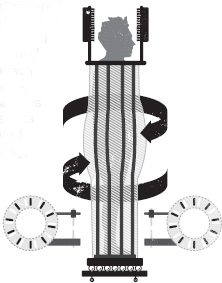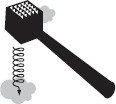Uncle John’s Bathroom Reader Weird Inventions (15 page)
Read Uncle John’s Bathroom Reader Weird Inventions Online
Authors: Bathroom Readers’ Institute

Hakes started again. And he ended up with the Mojito, a weird spiral-shaped shoe. At first sight, it doesn’t look like something a person could walk in: There’s a thick, curved squiggle supporting the heel of the foot, and one holding the ball of the foot, but the arch is left exposed as a curve of the spiral kicks back to serve as a high heel. The resulting shoe is reminiscent of a twist of lime as imagined by Lisa Frank after a weekend in a dungeon.
The shoe was a hit among fashion bloggers before production even began in earnest, and it has been available since 2012. Women who hate their feet but love looking crazy can pick up a pair for about $200.
T
hings shaped like human heads, if they are not human heads, are creepy and unsettling. In fact, so are human heads, if they are not attached to human bodies. Also creepy: Halloween, with its witches and ghosts and vine-covered pumpkins sitting in fields at night.
These universal truths were completely overlooked or ignored by Ohio inventor John Czeszcziczki, who in 1937 patented “Forming Configurations on Natural Growths.” In short, it’s a mold you place onto immature pumpkins so that as they grow and ripen, they take the shape of the mold. And Czeszcziczki’s main mold idea was that of a human head. This would result in pre-carved jack-o’-lanterns—Czeszcziczki evidently had trouble carving pumpkins, and in his patent he notes that “considerable skill is required to produce a good likeness.” But other people must have been happy with their pumpkin-carving skills because Czeszcziczki’s molds never took off.
In 1989 another inventor applied for a patent for molds that would have allowed zucchinis and other squash to grow into the shape of just the human face. Those didn’t go into wide production either, but the company that made them, Vegiforms, remains in business.
F
or the past few decades, children have looked blankly upon their parents when informed that there was once a time when people had to wash their dishes by hand. But we now stand on the cusp of an era when kids will find it uncanny that water was ever a part of the process. Designed by Halit Sancar, Gökçe Altun, Pinar Simsek and Nagihan Tuna, the DualWash Bipartite Dishwasher forgoes our old friend H
2
O in favor of its decidedly cooler cousin, CO
2
, pumping supercritical carbon dioxide into the cleaning chamber.
Because of its low surface tension, the liquid carbon dioxide covers the surface of the dishes, and when the CO
2
returns to its gaseous state, any residue previously left on the dishes is forced into the filter, which can be removed and cleaned after each use. Voilà—your dishes are clean, and they’re sterilized to boot! Plus, if it hasn’t occurred to you yet, the general dryness of the DualWash not only saves a significant amount of water, but it also saves space by serving quite effectively as a china storage cabinet.
B
y 1952 a 37-year-old designer and professional builder named Frances Gabe, of Newberg, Oregon, had had enough of the “thankless, unending, and nerve-twangling bore” of housework. So she designed and built a house that cleaned itself.
The house is built of cinder blocks to avoid termites and other wood-burrowing insects, and each room is fitted with a ceiling-mounted cleaning, drying, heating, and cooling device. The interior walls, floors, and ceilings are coated with resin to make them waterproof. The furniture is made entirely from waterproof composites. There are no carpets. The beds are covered automatically with waterproof material that rolls out from the foot of each bed. Easily damaged objects are protected under glass.
At the push of a few buttons, soapy water jets out from the ceiling to power-wash the rooms like an automatic car wash. The same jets then rinse off the soap, and then a huge built-in blower dries everything. The floors are sloped slightly at the corners so that excess water can run into a drain. The sink, shower, toilet, and tub clean themselves, too. So do the bookshelves and fireplace. The clothes closet serves as a washer and dryer, and the kitchen cabinets are dishwashers.
Gabe’s been living in her patented house ever since—she’s nearly 100 now, so maybe not doing all that housework has been good for her health.
F
or the better part of a century, Hollywood has tried and failed to win, in addition to the hearts and minds of film patrons, their nostrils, repeatedly trying to introduce smell into the movie-going experience. For example: Smell-O-Vision, Odorama, and Aroma-Scope.
Either the folks at Scent Sciences and Sensory Acumen haven’t read up on these past novelties/debacles in which smells were piped into movie theaters, or they must feel like they really know the noses of video-game players, because both companies have introduced systems designed to deliver game-appropriate odors in hopes of further immersing participants in whatever virtual reality they may be experiencing. Scent Sciences promises, “When synched with the action, scent-enabled media directs the release of ScentScape scents, providing background scents such as pine forest or ocean and from more scene related scents such as flowers and smoke to games or entertainment media.” Indeed, in the description of the awesomely named GameSkunk, Sensory Acumen giddily warns potential buyers, “Just wait; you will be catapulted into a whole new way of game play.”
F
ear is a great way to get people to let their guard down and tell you things they might not tell you when they have use of all their faculties and self-control. Also, what’s the scariest thing in the world? According to this invention from the 1930s, a skeleton ghost.
The Criminal Truth Extractor was designed for police to use to get suspects under interrogation to admit to the crimes for which they were being questioned. Here’s how it worked: The suspect sat in a chair in a small room. An officer in another room asked questions while viewing the suspect through a small window. (The whole thing would be recorded, too.) Also, the wall between the two rooms merely
looked
like a regular wall—however—it was extra thin, and when it looked like no good information was being given up, the interrogator could fire up the Truth Extractor—the lights went out and the thin wall lit up with he image of a ghostly skeleton with rapidly blinking eyes. The criminal gets scared, then confesses everything, so it went.
S
ure, it’s important to flesh-brush everyday, but it’s just so tedious and time-consuming. What? You don’t flesh-brush? Well, it’s no longer the 1880s, when the hottest hygiene fad going for the upper classes was using a soft brush to carefully scrub the body from head to toe and everywhere in between. It was so popular that in 1882 inventors Mary Stetson and William Bedell patented a mechanical Flesh Brushing Apparatus.
Saving the filthy filthy rich (or at least their servants) from having to scrub their bodies clean by hand, the Flesh Brushing Apparatus was a large, coffin-like tube that covered the body from the neck down and was lined with a dense forest of bristles made from “sea roots,” whatever those are. A person simply climbed in, fully nude, and cranked a handle that was nestled amidst the thousands of brush fibers. This rotated the bristles around the body, which, according to the patent “effected a great saving of time and of exertion.”

I
n the dark days before self-adhesive stamps, people actually had to lick their own postage before affixing it to an envelope. It was positively barbaric; not only was it time-consuming and a waste of precious saliva, it tasted nasty too. We’d rather brush our teeth and drink orange juice right after. And don’t even get us started on licking envelopes, what with the ever-present risk of debilitating paper cuts.
Thankfully, a creative fellow named Donald Poynter sought to deliver us from our long national nightmare with an invention cleverly described as a “device for moistening the adhesive coating on stamps and envelopes.” Poynter’s device is shaped like a box of tissues and has a plunger on top. When the plunger is depressed, a moistening arm shaped like human tongue moves up from a reservoir of water and sticks out of the box through an opening designed to look like a pair of lips. No explanation is provided for how this is more efficient than just using a damp sponge, or why someone would want to have such a creepy-looking thing on their desk.
T
his product, introduced in 2013, looks like a glass orb with a straw sticking out of it—not unlike a crack pipe. But it’s used to ingest another drug: alcohol. The Vaportini vaporizes alcoholic beverages so that users can get wasted just by breathing. The Vaportini works by way of a tealight that heats up your tipple of choice (the manufacturer recommends liquor of at least 70 proof, such as absinthe), causing it to evaporate into a fine mist that can be inhaled through a straw. All that pesky sipping, tasting, and savoring are over. For just $35, you can bypass your buzzkill of a digestive tract and absorb alcohol straight into your bloodstream.

The makers of the Vaportini claim that vaporizing alcohol removes all calories and carbohydrates, so you’ll never have to worry about feeling full or gaining weight. You can just keep inhaling and inhaling to your heart’s content, until your heart no longer works because you have died from alcohol poisoning.
W
atching the two-minute commercial for TV Hat—not
The
TV Hat, mind you, just “TV Hat”—you start to feel bad for the folks who invented it. They obviously thought it was a million-dollar idea—a wearable shield that lets you watch portable video wherever you go—but failed to take into account their creation’s fatal flaw: It looks darn goofy.

TV Hat is the quintessential late-night infomercial impulse buy, a product that seems like a good idea to customers in an altered state of mind at 2:00 a.m. The design is simply a ballcap with a flap of black fabric sewn along its freakishly long brim, forming a sort of rectangular tent that covers the user’s face. Slip a smartphone or iPod into the elastic pocket at the far end, put in earbuds, and you’re ready to watch video in complete privacy, with no glare, while keeping your hands free…so long as you don’t mind looking like the Elephant Man wearing a World War I gas mask. It’s like being in a private movie theater, where you cannot see or hear the inevitable mocking passers-by; TV Hat provides both a means to hide your face, and a reason to want to do so.
V
alentine’s Day falls in February, of course. The problem: That’s right in the middle of winter. Winter is cold in a great deal of the civilized world, and right around Valentine’s Day, people are left with a choice: hold hands with their sweetie, or wear mittens. Of course, you could wear mittens while you hold hands, but it’s almost impossible to get two hands covered in bulky fabric to stay locked together.